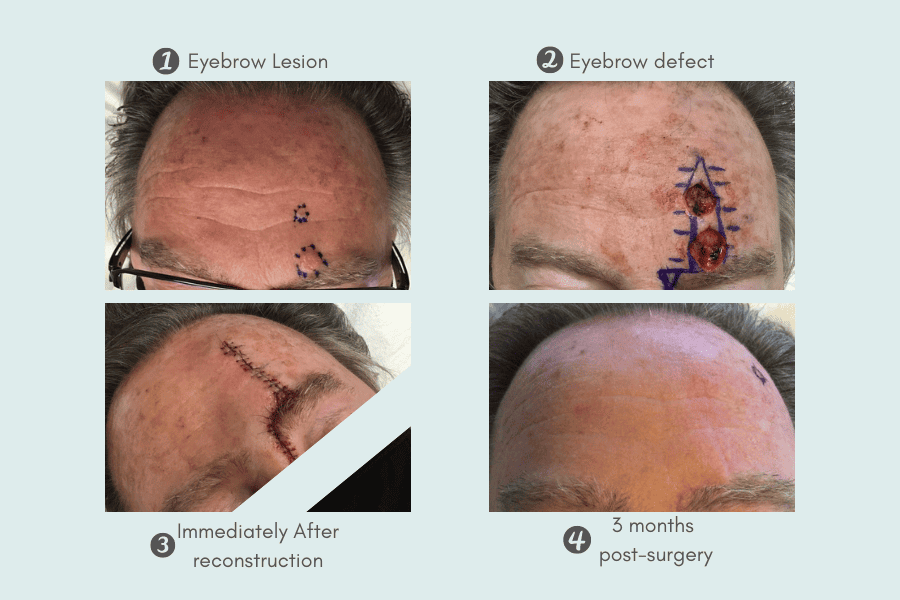Mohs
Home » Mohs

What is Mohs micrographic surgery?
Mohs surgery is a detailed surgical technique developed to treat skin cancer. During Mohs surgery, multiple stages of tissue removal and lab work are performed while the patient stays in the office. Small areas of the cancerous skin are removed in intervals. Lab work and examination occur until only healthy tissue is present. This process yields the total removal of the cancerous skin while saving healthy skin and leaving a cosmetically optimal scar.
Start your journey
to Beautiful skin!
What Types of Cancer Does Mohs Surgery Treat?
Mohs surgery is known for treating various forms of common skin cancers, including the following:
Melanoma
Melanoma occurs when the pigment-producing cells in the skin become cancerous. It is commonly found in preexisting moles or new dark spots and can occur anywhere on the body.
Basal Cell Carcinoma
Basal cell carcinoma is a type of skin cancer that begins in the basal cells of the skin. These cells are responsible for creating new skin cells. Basal cell carcinomas usually occur on sun-exposed skin like the face and neck.
Squamous Cell Carcinoma
Squamous cell skin cancer usually starts within a precancer (actinic keratosis) or as a growth on the skin that is made of up cancer cells. Squamous cells make up the middle and outer layers of the skin.
Merkel Cell Carcinoma
Merkel cell carcinoma is a rare form of skin cancer that is treatable with Mohs if it has not spread to other parts of the body. Merkel cell carcinomas usually develop as a result of excessive sun exposure or a weakened immune system due to advanced age.
Sebaceous Gland Carcinoma
Sebaceous gland carcinomas are malignant tumors in the sebaceous glands. These are skin glands found in your hair follicles that secrete sebum. These tumors usually arise on the eyelid but can occur anywhere on the body.
How is Mohs Surgery Different from Other Techniques?
Mohs surgery aims to remove as much skin cancer as possible layer by layer while doing minimal damage to the surrounding healthy tissue. Mohs surgery is a less invasive improvement to standard excisional cancer procedures. Standard excisional cancer removal procedures involve removing the visible cancer and a standardized margin around the skin cancer which can be healthy tissue.
Mohs surgery allows for lab testing and evaluation to confirm complete cancer cell removal at the time of the surgery, starting with smaller margins and only going larger as necessary to remove the entire cancerous lesion. This increases the probability of a cure at the time of surgery, is tissue sparing and decreases the likelihood of additional surgery.
Procedure
A local anesthetic is administered to the treatment area prior to the surgery. After the area is numb, the Mohs surgeon will use a scalpel to remove visible areas of the cancer. The Mohs surgeon will remove a very thin area of tissue underneath the area and surrounding the cancer. A bandage is applied to the site, and the removed tissue is taken to the lab for testing. The tissue sample is cut into sections and labeled like a clock. It is then looked at under a microscope by the Mohs surgeon. The surgeon maps out the tissue to track where each piece is on the body. This ensures that the surgeon knows where to continue the procedure. For example, if the surgeon sees cancerous tissue in the 12 o’clock region of the specimen, they will take an additional sample in that area only. The surgeon will continue this process until the last tissue sample removed and tested is cancer-free.
After
After the cancer tissue has been eliminated from the skin, your physician will decide how to close the wound. Options include stitches, using skin to cover the wound, or by letting the wound heal naturally. Mohs surgeons have specialized training in cosmetic reconstruction to give you an optimal cosmetic outcome.
Mohs micrographic surgery is typically performed outpatient, allowing you to go home immediately after surgery and repair.
After surgery, you may notice pain and tenderness at the surgery site and mild bleeding. Over-the-counter pain medications can help to diminish unwanted pain. You will be instructed to wear a bandage over the area for at least a week after the procedure. You may need to schedule a follow-up appointment after surgery to ensure the wound is healing as expected.
Results
Knowing that the skin cancer is entirely removed at the time of appointment is a significant advantage of Mohs surgery. Not only does Mohs surgery preserve your healthy skin, but it also uses in-depth examination techniques at the time of surgery to thoroughly remove the skin cancer.
Preventative Care Tips
The best way to treat skin cancer is by preventing it from occurring in the first place. When it comes to keeping you and your skin healthy, following these simple tips could be a lifesaver.
- Wear protective clothing.
- Avoid prolonged sun exposure.
- Apply SPF to sun-exposed areas.
- Always wear SPF regardless of if you have darker skin or fair skin.
- Wear a broad-spectrum sunscreen even on cloudy days.
- Know your family history of skin cancer.
- Routine skin examinations.
What to Expect On the Day of Surgery: Preparing for Mohs surgery & frequently asked questions
One to two weeks prior to surgery
Unless prescribed by a physician, we recommend stopping aspirin or aspirin containing medications 1 week prior to surgery. If you take aspirin for a medical condition or if it has been prescribed by a physician, you should continue this medication. We also recommend stopping herbal supplements including gingko biloba, ginseng, garlic, Vitamin E, Vitamin C, and fish oil which may increase your risk of bleeding. If you are taking a blood thinner, we DO NOT routinely recommend stopping this medication.
If you are a current smoker, we recommend smoking cessation 2 weeks prior and 2 weeks after surgery to optimize wound healing.
Day of surgery
We recommend wearing comfortable clothing and bringing a jacket in case get cold. We also recommend bringing a snack or reading material as there will be down time when the tissue is processing in the lab.
We recommend wearing comfortable clothing and bringing a jacket in case you are cold. We also recommend bringing a snack or reading material as there will be down time when the tissue is processing in the lab.
While Mohs surgery is a safe procedure, it has risks like any other surgical procedure including pain, bruising, bleeding, wound infection, and nerve damage. Your Mohs surgeon will discuss specific risks on the day of your procedure.
It is hard to predict the exact amount of time your procedure will take. On average, Mohs surgery can last anywhere between 2-4 hours, but in rare cases, a full day. We recommend clearing your schedule for the day. The initial “stage” typically takes 15-20 minutes. Afterwards, we will bandage you and direct you to the waiting room while the tissue is being processed in our laboratory. This part of the procedure typically takes 45 minutes to 1 hour. Additional “stages” (typically 1-3) may be required if skin cancer is still seen on the margins. Your Mohs surgeon precisely maps out tissue and will only remove tissue where skin cancer is still present. Once you are clear of your skin cancer, you will discuss repair options with your Mohs surgeon.
You and your Mohs surgeon will discuss how to best repair the wound. This includes letting the wound heal on its own (second intention), using stitches to close the wound, utilizing skin from an adjacent area (flap), or using a skin graft from another part of the body to cover the wound.
Most patients will experience minor pain and swelling which typically peak 48-72 hours after surgery. While Mohs surgery is a well-tolerated procedure, we will generally recommend Extra Strength Tylenol taken to help minimize any minor discomfort after the procedure. Cold packs or ice can also be helpful (not directly applied to wound) to alleviate pain or swelling after the procedure. Bruising, swelling, and minor drainage are common after Mohs surgery and typically subside over the following week. You should call your surgeon or go to the nearest emergency room if you are experiencing significant bleeding which does not stop after applying direct pressure for 20-30 minutes. Similarly, while infection is rare after Mohs surgery, you should call your surgeon if you are experiencing worsening pain after 48 hours, foul smelling drainage, or increasing redness around the wound site.
You and your Mohs surgeon will discuss wound care extensively on the day of surgery. In most cases, we will apply a “bulky” bandage immediately after your surgery which we recommend leaving in place and keeping dry for 48 hours. After 48 hours, we recommend removing the bandage and washing the Mohs surgical site with warm water and gentle soap such as Dove. Afterwards, we recommend applying a liberal layer of Vaseline or Aquaphor and covering the site with a bandage. Typically, this process is repeated daily until you return in 1 week for suture removal.
Most people are able to return to work or school the day following Mohs surgery. We recommend avoiding strenuous activity after Mohs surgery including lifting anything more than 10 lbs. While we recommend against strenuous exercise, light walking can be continued while the stitches are in place. Swimming and other water sports are not recommended as they may increase the risk of infection.
Yes. Any surgical procedure will inevitably result in some form of scar; however, Mohs surgery removes skin cancer while preserving normal, healthy tissue thus minimizing the appearance of scarring. Most importantly, scars continue to improve up to 1 year after a surgical procedure and will become less noticeable over time.
We will discuss additional wound care if necessary. While Mohs surgery offers the highest cure rate of any other skin cancer treatment option, recurrence is still possible. We recommend skin checks every 6 months to monitor for any recurrence.

